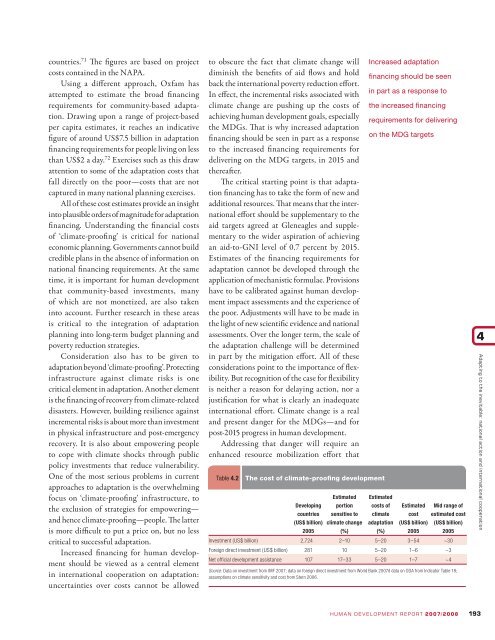The 21st Century climate challenge
The 21st Century climate challenge
The 21st Century climate challenge
Create successful ePaper yourself
Turn your PDF publications into a flip-book with our unique Google optimized e-Paper software.
countries. 71 <strong>The</strong> figures are based on projectcosts contained in the NAPA.Using a different approach, Oxfam hasattempted to estimate the broad financingrequirements for community-based adaptation.Drawing upon a range of project-basedper capita estimates, it reaches an indicativefigure of around US$7.5 billion in adaptationfinancing requirements for people living on lessthan US$2 a day. 72 Exercises such as this drawattention to some of the adaptation costs thatfall directly on the poor—costs that are notcaptured in many national planning exercises.All of these cost estimates provide an insightinto plausible orders of magnitude for adaptationfinancing. Understanding the financial costsof ‘<strong>climate</strong>-proofing’ is critical for nationaleconomic planning. Governments cannot buildcredible plans in the absence of information onnational financing requirements. At the sametime, it is important for human developmentthat community-based investments, manyof which are not monetized, are also takeninto account. Further research in these areasis critical to the integration of adaptationplanning into long-term budget planning andpoverty reduction strategies.Consideration also has to be given toadaptation beyond ‘<strong>climate</strong>-proofing’. Protectinginfrastructure against <strong>climate</strong> risks is onecritical element in adaptation. Another elementis the financing of recovery from <strong>climate</strong>-relateddisasters. However, building resilience againstincremental risks is about more than investmentin physical infrastructure and post-emergencyrecovery. It is also about empowering peopleto cope with <strong>climate</strong> shocks through publicpolicy investments that reduce vulnerability.One of the most serious problems in currentapproaches to adaptation is the overwhelmingfocus on ‘<strong>climate</strong>-proofing’ infrastructure, tothe exclusion of strategies for empowering—and hence <strong>climate</strong>-proofing—people. <strong>The</strong> latteris more difficult to put a price on, but no lesscritical to successful adaptation.Increased financing for human developmentshould be viewed as a central elementin international cooperation on adaptation:uncertainties over costs cannot be allowedto obscure the fact that <strong>climate</strong> change willdiminish the benefits of aid flows and holdback the international poverty reduction effort.In effect, the incremental risks associated with<strong>climate</strong> change are pushing up the costs ofachieving human development goals, especiallythe MDGs. That is why increased adaptationfinancing should be seen in part as a responseto the increased financing requirements fordelivering on the MDG targets, in 2015 andthereafter.<strong>The</strong> critical starting point is that adaptationfinancing has to take the form of new andadditional resources. That means that the internationaleffort should be supplementary to theaid targets agreed at Gleneagles and supplementaryto the wider aspiration of achievingan aid-to-GNI level of 0.7 percent by 2015.Estimates of the financing requirements foradaptation cannot be developed through theapplication of mechanistic formulae. Provisionshave to be calibrated against human developmentimpact assessments and the experience ofthe poor. Adjustments will have to be made inthe light of new scientific evidence and nationalassessments. Over the longer term, the scale ofthe adaptation <strong>challenge</strong> will be determinedin part by the mitigation effort. All of theseconsiderations point to the importance of flexibility.But recognition of the case for flexibilityis neither a reason for delaying action, nor ajustification for what is clearly an inadequateinternational effort. Climate change is a realand present danger for the MDGs—and forpost-2015 progress in human development.Addressing that danger will require anenhanced resource mobilization effort thatTable 4.2 <strong>The</strong> cost of <strong>climate</strong>-proofing developmentIncreased adaptationfinancing should be seenin part as a response tothe increased financingrequirements for deliveringon the MDG targetsDevelopingcountries(US$ billion)2005Estimatedportionsensitive to<strong>climate</strong> change(%)Estimatedcosts of<strong>climate</strong>adaptation(%)Estimatedcost(US$ billion)2005Mid range ofestimated cost(US$ billion)2005Investment (US$ billion) 2,724 2–10 5–20 3–54 ~30Foreign direct investment (US$ billion) 281 10 5–20 1–6 ~3Net offi cial development assístance 107 17–33 5–20 1–7 ~4Source: Data on investment from IMF 2007; data on foreign direct investment from World Bank 2007d data on ODA from Indicator Table 18;assumptions on <strong>climate</strong> sensitivity and cost from Stern 2006.4Adapting to the inevitable: national action and international cooperationHUMAN DEVELOPMENT REPORT 2007/2008 193




